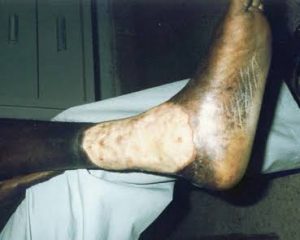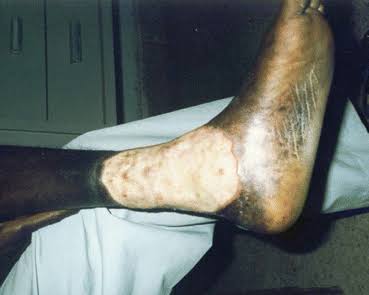How and Why does sickle cell disease cause leg ulcers?
👇👇👇💥💥💥💥💥💥💥💥💥👇👇👇
Sickle cell Disease; Leg ulcer as one of its complication: The why?
Introduction
Over the years, the cause of chronic leg ulcer in sickle cell disease patients has been a subject of discuss in order to know why it occurs and how best to either prevent or manage them. But before we do justice to our topic of discuss, lets quickly look at what sickle cell disease entails.
Sickle cell disease is an inherited genetic condition that involves defects in the shape and function of haemoglobin (oxygen carrying pigment) in the blood. This defect increases the likelihood of blockages in the blood vessels and disrupt blood flow, which can result in serious complications.
Sickle cell disease affects virtually every part of the body causing various complications, some of which includes; Bone pain, Acute chest Syndrome, Hand-foot syndrome, aplastic Anaemia, priapism, kidney Failure and of course leg ulcers.
Today we would be looking at how sickle cell disease cause leg ulcers.
LEG ULCERS IN SICKLE CELL DISEASE PATIENTS
One of the known complications of sickle cell disease is leg ulcer which is relatively common and can be disabling. Chronic leg ulcerations are more common in sickle cell anaemia patient (HbSS) and less often seen in patients with HbSC disease or in Thalassemia patient.
The commonest site of these ulcers are mainly the medial and lateral malleoli(ankles) with the medial malleoli being more affected compared to the lateral malleoli. Less common sites are the anterior tibia, Achilles tendon and dorsum of the foot.
The reason why its common in these areas is simply due to the fact that these areas are less vascularized coupled with less subcutaneous fat and thin skin.
Pathogenesis of Leg ulcers in sickle cell disease
Previously, it was thought that the cause of leg ulcers in sickle cell disease was due to venous insufficiency. However, recent studies have shown that it is not entirely true but rather, due to a number of different contributing factors in a complex manner.
The various factors include, obstruction of blood vessels by a dense sickled red cells, bacterial infection, trauma, venous incompetence, abnormal autonomic control with excessive vasoconstriction and anaemia complicated by decreased oxygen carrying capacity of the red cells.
The exact pathophysiology of leg ulcer in SCD patient is unknown, and the causative mechanism is thought to be multifactorial.

Credit: Springerlink
Etiological factors include sickling of red cells in blood vessels, causing vasoocclusion and impairing oxygen delivery to tissue as well as the binding of hemolysis freed hemoglobin
to nitric oxide, deactivating it and subsequently resulting in vaso-constriction.
All the earlier mechanisms can either occur spontaneously in a patient with SCD or alternatively be caused by trauma which may start a cascade of the aforementioned mechanisms, leading to ulcer formation.
Conclusion
Longevity with reduced morbidity is what we strive to achieve daily as medical practitioners in regards to sickle cell disease. In as much as leg ulcers in SCD patients does not necessary result to death, it can reduce the quality of life of these individuals. It is therefore imperative for us to know why and how these ulcers develop and how to either prevent or manage them.
There will be a separate article on how to prevent and manage leg ulcers in sickle cell disease patients.
Written by Sapele Samson (MBBS BENIN)





















